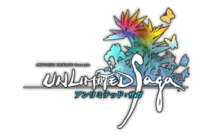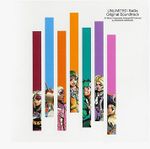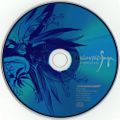Welcome to the SaGa Wiki! We have moved off Fandom very recently, so things are still being set up around here. Please note that some images did not successfully transfer, and will need to be manually reuploaded or replaced.
Note: Keep in mind that once you have an account, you must wait one day and make 5 edits to become autoconfirmed. This allows you to skip questions while editing, to create new articles, and to upload images.
Difference between revisions of "Unlimited Saga"
gkIcysugarspike (talk) (→Audio) |
gkIcysugarspike (talk) (→Audio) |
||
| Line 36: | Line 36: | ||
The [[Unlimited Saga Original Soundtrack|game's soundtrack]] consists of 58 songs spanning two discs. It was released on January 22, 2003.[[File:US_OST1.jpg|thumb|150px|Unlimited Saga Original Soundtrack]] | The [[Unlimited Saga Original Soundtrack|game's soundtrack]] consists of 58 songs spanning two discs. It was released on January 22, 2003.[[File:US_OST1.jpg|thumb|150px|Unlimited Saga Original Soundtrack]] | ||
It was composed by [http://en.wikipedia.org/wiki/Masashi_Hamauzu Masashi Hamauzu], while synthesizer programming was done by [http://en.wikipedia.org/wiki/Ryo_Yamazaki Ryo Yamazaki]. The two previously collaborated on the soundtrack for ''[http://en.wikipedia.org/wiki/SaGa_Frontier_2 SaGa Frontier 2]'' after the departure of previous series composer [http://en.wikipedia.org/wiki/Kenji_Ito Kenji Ito], who later returned as main composer for [[Romancing SaGa: Minstrel Song]] while Hamauzu was appointed to Sigma Harmonics and Final Fantasy XIII among the others. | It was composed by [http://en.wikipedia.org/wiki/Masashi_Hamauzu Masashi Hamauzu], while synthesizer programming was done by [http://en.wikipedia.org/wiki/Ryo_Yamazaki Ryo Yamazaki]. The two previously collaborated on the soundtrack for ''[http://en.wikipedia.org/wiki/SaGa_Frontier_2 SaGa Frontier 2]'' after the departure of previous series composer [http://en.wikipedia.org/wiki/Kenji_Ito Kenji Ito], who later returned as main composer for [[Romancing SaGa: Minstrel Song]] while Hamauzu was appointed to Sigma Harmonics and Final Fantasy XIII among the others. Because the game uses [http://en.wikipedia.org/wiki/Streaming_audio_in_video_games streaming audio], it was possible for the sound team to use real acoustic instrument sounds in place of a synthesizer.[[File:US_OST2.jpg|left|thumb|120px|Unlimited Saga Maxi Single CD]] Live recording of chamber ensembles of tracks such as "''Feel Uneasy About the Wonders''" and "''Battle Theme IV''" pitted solo instruments against one another to create what Hamauzu considered a Latin sound. While the [[Unlimited Saga Original Soundtrack#Disc One|first CD]] features more classical-oriented, emotional character and town themes, the [[Unlimited Saga Original Soundtrack#Disc Two|second disc]] concentrates on techno-driven, jazzy battle and dungeon themes. The ending vocal piece "Soaring Wings" was written specifically for singer [http://en.wikipedia.org/w/index.php?title=Mio_Kashiwabara&action=edit&redlink=1 Mio Kashiwabara]. | ||
Revision as of 16:53, December 21, 2011
Unlimited Saga (アンリミテッド: サガ, Anrimiteddo: Saga) is a Squaresoft RPG for the PlayStation 2. It is the ninth game in the SaGa series. Originally released in Japan in December 2002, the game was later made available for North American players in June 2003 and in Europe the following October.
Plot
The game features seven protagonists to choose from:
- Mythe - The assistant of a famous inventor, who falls in love with a silver haired girl he sees on a painting.
- Ventus - A carrier who wishes to find out who murdered his brother.
- Kurt - A former knight who wishes to discover the mystery of his cursed gauntlet.
- Judy - The youngest member of a family of wizards. She must save her family.
- Armic - A member of the Chapa tribe, sent on a quest to gather ingredients for a ceremony to summon rain.
While all characters have their own storyline, they do encounter each other during their adventures. One of the main elements which connects all stories is the legend of Iskandar and The Seven Wonders. The characters tend to stumble across each other at the Festival of Regina Leone in Vaftom, however, some join another main characters' party at other points in the different scenarios.
Characters
Aside from the main cast, the game features many recruitable characters of which some are random encounters who just decide to join and others are integrated into the character's plot. However, no matter the case... not even if the character is a main character or not... all characters are present in 2 scenarios, hence when playing the game with a different character, you will unavoidably see both new and old faces. Each main character scenario has 9 playable characters of which you'll have to later pick 7 ones to take on each mission. However there is an exception: one single character is present in one scenario only (that being Ruby's scenario) and that is Iskandar.
Some of the characters are also split among other scenarios in specific ways. Each main character has another main character to recruit, with the exception of Laura and Armic; where Laura has both Judy and Armic, while Armic can recruit no additional main character. In Judy's Scenario, the player is able to recruit her entire family, but in all other scenarios the family is split: Judy is in Laura's scenario, her father is in Ventus' scenario, her mother in Armic's, her brother in Ruby's, her sister in Mythe's and her grandpa in Kurt's.
You can find the entire list of characters along with their attributes, starting Growth Panel and which main scenarios they appear in: List of characters in Unlimited Saga.
Game System
Unlimited Saga was highly experimental and featured a lot of concepts and idea which seemed new even to fans of the SaGa series, moreso to people who never had connection with other titles.
- LP- The Life Point system returns once again, however in this case it's even more important than in other SaGa games.
- Growth Panel- A character developement system where the character would gain 1 new panel after each quest.
- Reel System- During battle the level and strength of a command you'd use would be determined by a slot machine.
- Board game- Outside of battle, the character is a silver figure that moves on the map, field by field, turn by turn.
- Blacksmith- The ability to create, repair and modify a character's equipment in certain towns.
- Arts & Spells- The attacks you can use in battle. Stronger Arts are unlocked by using others repeatedly in battle.
- Carrier System - A unique gameplay element for Ventus, offering an infinite number of quests delivering objects from one city to another.
Audio
The game's soundtrack consists of 58 songs spanning two discs. It was released on January 22, 2003.
It was composed by Masashi Hamauzu, while synthesizer programming was done by Ryo Yamazaki. The two previously collaborated on the soundtrack for SaGa Frontier 2 after the departure of previous series composer Kenji Ito, who later returned as main composer for Romancing SaGa: Minstrel Song while Hamauzu was appointed to Sigma Harmonics and Final Fantasy XIII among the others. Because the game uses streaming audio, it was possible for the sound team to use real acoustic instrument sounds in place of a synthesizer.
Live recording of chamber ensembles of tracks such as "Feel Uneasy About the Wonders" and "Battle Theme IV" pitted solo instruments against one another to create what Hamauzu considered a Latin sound. While the first CD features more classical-oriented, emotional character and town themes, the second disc concentrates on techno-driven, jazzy battle and dungeon themes. The ending vocal piece "Soaring Wings" was written specifically for singer Mio Kashiwabara.
The limited JP edition of the game also included a promotional Unlimited Saga Maxi Single CD, containing three songs extracted from the OST: "Ouverture", "Battle Theme I" and "Soaring Wings".
See also
Gallery
| Main characters | Armic - Judy - Kurt - Laura - Mythe - Ruby - Ventus |
| Playable characters | Anzan - Armand - Edel - Francis - Grace - Henri - Hiro - Iskandar - Josef - Kong Ming - Marie - Michelle - Mordeus - Musol Yanii - Norff - Nuage - Pharr - Platyphyllum - Rebecca - Roy - Sapphire - Silver Girl - Thomas - Tiffon - Vearst |
| Non-playable characters | Alyce Ambrosia - Briza - Emerald - Leith Torles |
| Villains | Basil Galeos - Chaos - Clyde Blackstorm - Dagul Bos - Jeanne Maure - Kalandorn Alovi - Leon Burgundy - Phantom (Knights of the Round Table) - Yun Crimsonrain |





